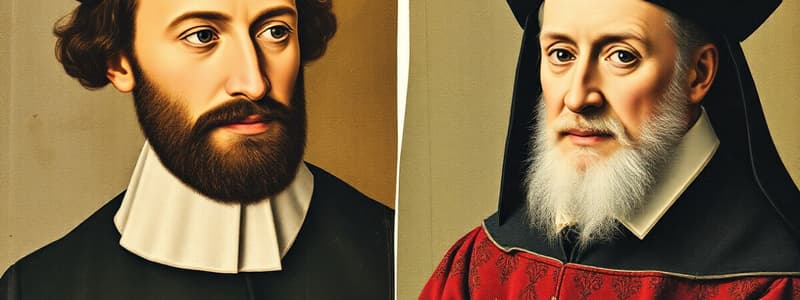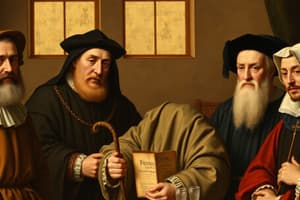Podcast
Questions and Answers
Which Renaissance figure is famously known for his love poems dedicated to Laura?
Which Renaissance figure is famously known for his love poems dedicated to Laura?
- Vitruvian Man
- Lorenzo de Medici
- Francesco Petrarch (correct)
- Thomas More
Which figure is credited with spreading Protestant thought in Zurich, Switzerland?
Which figure is credited with spreading Protestant thought in Zurich, Switzerland?
- Huldreich Zwingli (correct)
- John Calvin
- Martin Luther
- John Knox
Which of the following is NOT a factor contributing to the Age of Exploration?
Which of the following is NOT a factor contributing to the Age of Exploration?
- Desire for power and prestige
- The Renaissance (correct)
- Religious motives
- Commercial Revolution
- Improvements in maritime science
What was a key result of Magellan's expedition?
What was a key result of Magellan's expedition?
Which of the following individuals is NOT associated with the Catholic Church?
Which of the following individuals is NOT associated with the Catholic Church?
What is the characteristic feature of Humanism?
What is the characteristic feature of Humanism?
Which of the following works is NOT attributed to Leonardo da Vinci?
Which of the following works is NOT attributed to Leonardo da Vinci?
What is the primary characteristic of Scholasticism?
What is the primary characteristic of Scholasticism?
Which of the following is NOT a defining characteristic of Humanism?
Which of the following is NOT a defining characteristic of Humanism?
According to the content, what is the significance of the "Sonnet of Laura"?
According to the content, what is the significance of the "Sonnet of Laura"?
What is the main theme explored in the novel "Don Quixote de la Mancha"?
What is the main theme explored in the novel "Don Quixote de la Mancha"?
Which of these books presents a critical view of society through satire?
Which of these books presents a critical view of society through satire?
Which of the following is closely associated with the idea of "The end must justify the means"?
Which of the following is closely associated with the idea of "The end must justify the means"?
What is the purpose of the "Vitruvian Man" drawing?
What is the purpose of the "Vitruvian Man" drawing?
What does the phrase "The end must justify the means" imply?
What does the phrase "The end must justify the means" imply?
Which of these is NOT a defining element of the Renaissance?
Which of these is NOT a defining element of the Renaissance?
Which of the following best describes the concept of Machiavellianism?
Which of the following best describes the concept of Machiavellianism?
What is the main characteristic of the Mannerism artistic style?
What is the main characteristic of the Mannerism artistic style?
Which artistic style emerged during the late Renaissance, characterized by exaggerated forms and emotional intensity?
Which artistic style emerged during the late Renaissance, characterized by exaggerated forms and emotional intensity?
What is the significance of "The Book of Courtier" by Baldassare Castiglione?
What is the significance of "The Book of Courtier" by Baldassare Castiglione?
Which dynasty in China is directly linked to the construction of the Grand Canal and the Great Wall of China?
Which dynasty in China is directly linked to the construction of the Grand Canal and the Great Wall of China?
Which of the following is considered a significant work of literature by François Rabelais?
Which of the following is considered a significant work of literature by François Rabelais?
Which artistic style is represented by Michelangelo's "Pieta" sculpture?
Which artistic style is represented by Michelangelo's "Pieta" sculpture?
Flashcards
Bacchus
Bacchus
Roman god of wine and revelry.
Francesco Petrarch
Francesco Petrarch
Italian poet known as the 'father of Humanism', famous for Canzoniere.
Vitruvian Man
Vitruvian Man
Leonardo da Vinci's drawing illustrating ideal human proportions.
Utopia
Utopia
Signup and view all the flashcards
Martin Luther
Martin Luther
Signup and view all the flashcards
Humanism
Humanism
Signup and view all the flashcards
Scholasticism
Scholasticism
Signup and view all the flashcards
John Calvin
John Calvin
Signup and view all the flashcards
What a glorious time to be alive
What a glorious time to be alive
Signup and view all the flashcards
The end must justify the means
The end must justify the means
Signup and view all the flashcards
Renaissance
Renaissance
Signup and view all the flashcards
Machiavellian
Machiavellian
Signup and view all the flashcards
Mannerism
Mannerism
Signup and view all the flashcards
The Book of Courtier by Baldassare Castiglione
The Book of Courtier by Baldassare Castiglione
Signup and view all the flashcards
Pieta
Pieta
Signup and view all the flashcards
The Last Judgment
The Last Judgment
Signup and view all the flashcards
The Prince
The Prince
Signup and view all the flashcards
Sonnet of Laura
Sonnet of Laura
Signup and view all the flashcards
Study Notes
I. Identify Figures and Concepts
- Bacchus: Roman god of wine and revelry
- Francesco Petrarch: Italian poet, considered the "father of Humanism," known for his Canzoniere
- Printing Press: In use in China and Korea before the Renaissance
- Sonnet to Laura: Petrarch's famous love poems dedicated to Laura
- Vitruvian Man: Leonardo da Vinci's drawing illustrating ideal human proportions
- Utopia: Thomas More's book describing a perfect society
- Lorenzo de Medici: Florentine ruler and art patron, key figure in Renaissance culture
- John Knox: Established the Presbyterian Church in Scotland
- Girolamo Savonarola: Ordered the destruction of Renaissance works
- Jan Hus: His persecution led to the Hussite Wars
- John Calvin: Proponent of predestination doctrine
- Martin Luther: Protested against corruption in the Church, an Augustinian monk
- Huldereich Zwingli: Spread Protestant thoughts in Zurich, Switzerland
II. Identify Figures and Concepts (Page 2)
- St. John of the Cross: Mystic who suffered physically from Catholic superiors
- St. Teresa of Avila: Mystic doctor of the church, founder of the Order of Barefoot nuns
- St. Francis Xavier: Spread Christianity in India, Sri Lanka, China, and Japan
- Mateo Ricci: Established a religious order ("soldiers of Christ")
- St. Edmund Campion: One of the "Forty Martyrs of England," converting Anglicans
III. Enumeration (Page 2)
- Humanities Subjects: Art, music, literature, religious studies, history, and philosophy
- Leonardo da Vinci's Works: Mona Lisa, The Last Supper, Vitruvian Man
- Factors Leading to Exploration: Improvements in maritime science, religious motives, competition for power and prestige, Commercial Revolution
- Importance of Magellan's Exploration: (Details not provided)
IV. Define Concepts (Page 3)
- Scholasticism: A medieval method of learning that combined faith and reason, attempting to reconcile Christian theology with ancient philosophy.
- Humanism: A Renaissance movement focusing on human potential, individualism, and the study of classical texts
- "What a glorious time to be alive": A phrase expressing excitement and optimism about living in a period of progress or opportunity
- "The end must justify the means": The idea that morally questionable actions are acceptable if they lead to a good outcome
- Renaissance: A period of cultural rebirth in Europe, focused on art, science, and classical learning
- Machiavellian: A political approach where achieving power justifies using deceit and manipulation
- Mannerism: A late Renaissance art style characterized by exaggerated forms and emotional intensity
- The Book of the Courtier by Baldassare Castiglione: A guide to the ideal behavior of a noble or courtier, emphasizing grace, intelligence, and etiquette
V. Literary Works and Styles (Page 5)
- Mannerism: A late Renaissance style emphasizing exaggeration, artificial poses, and emotional intensity, deviating from classical harmony
- Pieta: Michelangelo's sculpture of the Virgin Mary holding the dead body of Jesus
- The Last Judgment: Michelangelo's fresco depicting the second coming of Christ and the final judgment of souls
- The Prince: Machiavelli's political treatise advising rulers on gaining and maintaining power through pragmatic methods
- Utopia: Thomas More's book describing an ideal society
- Utopian: Referring to an idealized, perfect society that is often unrealistic or unattainable
- Vitruvian Man: Leonardo da Vinci's drawing illustrating human proportions based on ancient texts
- Don Quixote de la Mancha: Cervantes' novel about an idealistic knight-errant who reflects on idealism vs. reality
VI. Complete the Analogy (Page 4)
- (Analogies provided, but specific details about each Kingdom or Empire are not given.)
VII. Define (Page 6)
- Scholasticism: A medieval system of thought that attempted to harmonize reason and faith.
- Humanism: A Renaissance movement focused on human potential, classical learning, and individualism.
- "What a glorious time to be alive": A phrase expressing excitement and optimism for a period of progress
- "The end must justify the means": The idea that questionable actions are acceptable if they achieve a good outcome
- Renaissance: A period of cultural rebirth in Europe, emphasizing art, science, and classical learning
- Machiavellian: A political approach emphasizing ruthless tactics for power
- Mannerism: A late Renaissance art style characterized by exaggerated figures and emotional intensity
- In Praise of Folly: Erasmus' satirical work criticizing societal corruption, particularly church practices
Studying That Suits You
Use AI to generate personalized quizzes and flashcards to suit your learning preferences.




